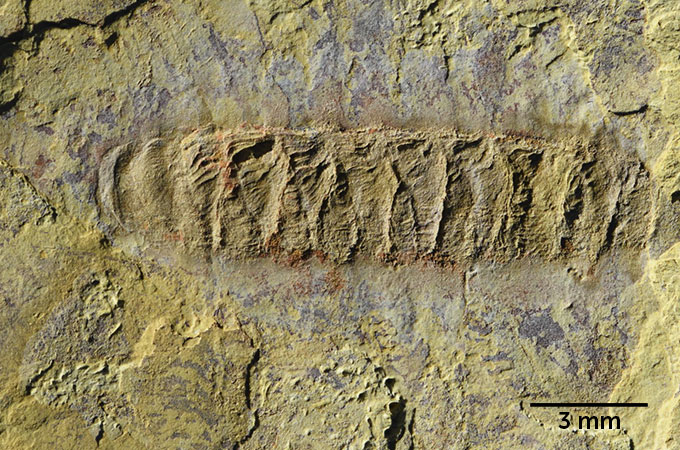Allison Gasparini writes:
An ancient, armored worm may be the key to unraveling the evolutionary history of a diverse collection of marine invertebrates.

Discovered in China, a roughly 520-million-year-old fossil of the newly identified worm, dubbed Wufengella, might be the missing link between three of the phyla that constitute a cadre of sea creatures called lophophorates.
Based on a genetic analysis, Wufengella is probably the common ancestor that connects brachiopods, bryozoans and phoronid worms, paleontologist Jakob Vinther and colleagues report September 27 in Current Biology.
“We had been speculating that [the common ancestor] may have been some wormy animal that had plates on its back,” says Vinther, of the University of Bristol in England. “But we never had the animal.”
Roughly half a billion years ago, nearly all major animal groups burst onto the scene in a flurry of evolutionary diversification during what’s known as the Cambrian explosion (SN: 4/24/19). During this time, lophophorates experienced a rapid growth of species, which has obscured the group’s evolutionary history.
The fossil is a “great find,” says Gonzalo Giribet, an invertebrate zoologist at Harvard University who was not involved in the research. Still, the scientists’ analysis does not confirm that Wufengella is the long-sought missing link, he cautions, but rather suggests it.
Some researchers had hypothesized that lophophorates’ common ancestor would be a stationary creature that sat on the seafloor and fed only through tubes, similar to its modern kin. The Wufengella fossil could refute this idea; the animal’s body plan suggests instead that it crawled around, the researchers say.
A fossil like Wufengella had long been high on Vinther’s bucket list of fossils that he and his colleagues hoped to find. But “we always thought, ‘Well, we probably will never see that in real life,’” he says. Typically, such a creature would have spent its life in shallow water. Organisms don’t tend to preserve well there, decaying faster due to exposure to lots of oxygen. Vinther suggests that the Wufengella that his team found probably washed out to deep water in a storm.
Now that the researchers have found one Wufengella, they hope to find more, in part to see if there are other varieties. And perhaps the team could identify even more distant ancestors further back on the tree of life that might connect lophophorates with other animal groups such as mollusks, Vinther says, further fleshing out how life on Earth is connected.
Full article at Science News.
In terms of the science, the Wufengella fossil is the observable evidence. “Evolutionary history,” “missing link,” and “common ancestor” are not logically deduced from this evidence, but presumptively assumed conclusions. The “Cambrian explosion” mentioned in this article, is supported by extensive fossil evidence, and falls outside of the framework of the evolutionary story line.